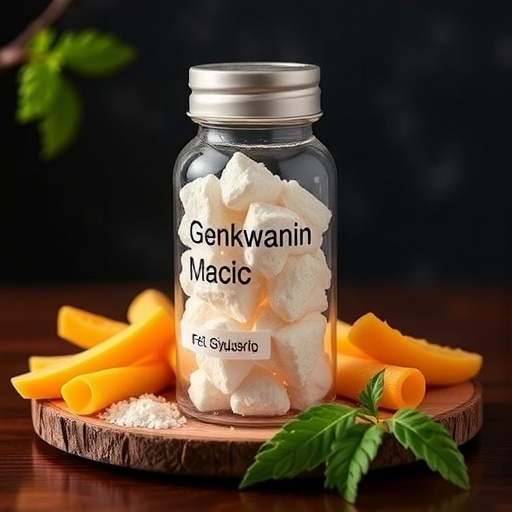The significance of glucose homeostasis in metabolic health cannot be overstated. Dysregulation of glucose levels in the bloodstream is a hallmark of diabetes mellitus, a chronic condition affecting hundreds of millions worldwide. Traditional therapies focus primarily on controlling blood glucose through various pharmaceutical approaches, yet many patients struggle with side effects or insufficient efficacy. The identification of plant-derived compounds capable of directly enhancing glucose uptake at the cellular level represents a paradigm shift. Genkwanin glycosides in Phaleria nisidai have drawn attention due to their natural occurrence and potent biological activity, offering hope for more effective, safer alternatives to current diabetes treatments.
Delving into the biochemical interplay, the research team, led by Horvath, Houriet, and Kellenberger, conducted an extensive analysis of the crude extract from Phaleria nisidai. Using advanced chromatographic and spectrometric techniques, they isolated multiple flavonoid glycosides, with genkwanin derivatives emerging as the compounds exerting the most pronounced effect on glucose metabolism. This was confirmed through in vitro assays demonstrating enhanced glucose uptake in cultured adipocytes. The data indicate that these glycosides facilitate cellular glucose transport mechanisms, potentially through modulating key glucose transport proteins such as GLUT4, which play pivotal roles in adipose tissue functionality and systemic glucose regulation.
.adsslot_CEw2vUcmnN{ width:728px !important; height:90px !important; }
@media (max-width:1199px) { .adsslot_CEw2vUcmnN{ width:468px !important; height:60px !important; } }
@media (max-width:767px) { .adsslot_CEw2vUcmnN{ width:320px !important; height:50px !important; } }
ADVERTISEMENT
Adipose tissues, often overlooked beyond their role in fat storage, are critical regulators of whole-body metabolic homeostasis. The ability of genkwanin glycosides to stimulate glucose uptake specifically into adipocytes is noteworthy. This preferential action ensures that excess glucose is efficiently cleared from the bloodstream and stored in a metabolically active form, mitigating hyperglycemic episodes. Moreover, adipocytes secrete signaling molecules known as adipokines, which influence insulin sensitivity and inflammation. Enhancing glucose influx into these cells might recalibrate adipokine secretion, further contributing to improved insulin responsiveness and metabolic health.
The mechanistic insights gained from this study underscore the intersection of natural product chemistry and cellular metabolism. The glycosidic moiety in genkwanin enhances its solubility and bioavailability, which are critical factors determining the compound’s efficacy in vivo. Molecular docking and computational modeling indicated strong binding affinities of genkwanin glycosides to the signaling pathways regulating glucose transporters. This dual approach of experimental and in silico methods strengthens the causal link between genkwanin glycoside administration and improved glucose handling by adipose tissues.
Importantly, experimental models demonstrated that administration of Phaleria nisidai extract or purified genkwanin glycosides resulted in improved glucose tolerance and insulin sensitivity in rodent models of diet-induced insulin resistance. These physiological effects mimic those sought in clinical diabetes management, suggesting translational potential. Furthermore, no significant adverse effects were reported in these preclinical trials, highlighting the extract’s safety profile—a critical parameter in novel therapeutic development.
With the epidemic rise of metabolic diseases, the demand for novel, effective treatments with minimal side effects is urgently needed. The isolation of genkwanin glycosides from Phaleria nisidai opens new avenues for naturally derived glucose modulators. Unlike synthetic drugs often burdened with toxicity or complex synthesis routes, these plant-derived compounds could be produced sustainably, offering cost-effective and accessible alternatives, especially in low-resource settings. The use of traditional medicinal plants as sources of cutting-edge medical treatments exemplifies the synergy between ethnobotanical knowledge and modern biomedical research.
Researchers emphasize that the next steps involve rigorous clinical trials to evaluate efficacy, dosage, and safety in humans. Furthermore, understanding the pharmacokinetics and long-term metabolic effects of genkwanin glycosides will be vital before integration into standard care. Ongoing studies are also exploring potential synergistic effects when combined with existing antidiabetic drugs, enhancing therapeutic outcomes or reducing required dosages.
Beyond glucose uptake, genkwanin glycosides may exert pleiotropic effects beneficial for metabolic syndrome. Flavonoids, as a class, are known for antioxidant, anti-inflammatory, and endothelial-protective properties. These additional mechanisms could ameliorate vascular complications associated with chronic hyperglycemia, providing a comprehensive protective strategy against the multifaceted impacts of diabetes.
This discovery also reinvigorates interest in plant flavonoids as a versatile and potent group of biologically active substances. The structural nuances in genkwanin glycosides that confer their metabolic effects could guide the design of novel analogs with optimized properties. Medicinal chemists are especially interested in modifying the sugar residues or flavonoid backbone to enhance specificity, potency, and pharmacodynamics.
In the age of personalized medicine, compounds like genkwanin glycosides could be tailored to target patient-specific glucose handling dysfunctions. Genetic variations affecting glucose transporter expression or insulin sensitivity might define subsets of patients who would benefit most. Biomarker-driven clinical assessments could refine treatment regimens, moving away from one-size-fits-all approaches to individualized metabolic therapies.
Moreover, environmental and cultivation factors influencing Phaleria nisidai phytochemical profiles are under investigation. Optimizing growth conditions or employing biotechnological methods such as plant cell cultures may maximize yield and consistency of genkwanin glycosides. These advances pave the way for scalable production, necessary for industrial pharmaceutical applications.
The findings from Horvath and colleagues spotlight the untapped potential residing within traditional medicinal plants. By marrying meticulous chemical analysis with physiological validation, the research bridges centuries-old botanical wisdom with modern metabolic science. As the scientific community races to battle diabetes and its complications, genkwanin glycosides represent a compelling beacon of hope illuminated by nature’s intricate molecular arsenal.
In summary, the identification of genkwanin glycosides as the chief bioactive constituents in Phaleria nisidai that directly stimulate glucose uptake into adipose tissue marks a major stride in diabetes research and therapy development. This natural compound’s capacity to restore balanced glucose homeostasis offers a refreshing, innovative therapeutic strategy. With further validation and development, genkwanin glycosides could seamlessly integrate into the future landscape of metabolic disease management, changing countless lives burdened by glucose dysregulation worldwide.
Subject of Research: The metabolic effects of genkwanin glycosides isolated from Phaleria nisidai on glucose homeostasis and glucose uptake in adipose tissues.
Article Title: Genkwanin glycosides are major active compounds in Phaleria nisidai extract mediating improved glucose homeostasis by stimulating glucose uptake into adipose tissues.
Article References:
Horvath, C., Houriet, J., Kellenberger, A. et al. Genkwanin glycosides are major active compounds in Phaleria nisidai extract mediating improved glucose homeostasis by stimulating glucose uptake into adipose tissues. Nat Commun 16, 7648 (2025). https://doi.org/10.1038/s41467-025-62689-8
Image Credits: AI Generated
Tags: adipose tissue glucose regulationbotanical candidates for metabolic healthdiabetes management breakthroughsgenkwanin glycosidesglucose homeostasis mechanismsglucose uptake enhancementmetabolic disorders treatmentnatural remedies for diabetesPhaleria nisidai extractplant-derived compounds for diabetestraditional medicine and modern researchtype 2 diabetes interventions





